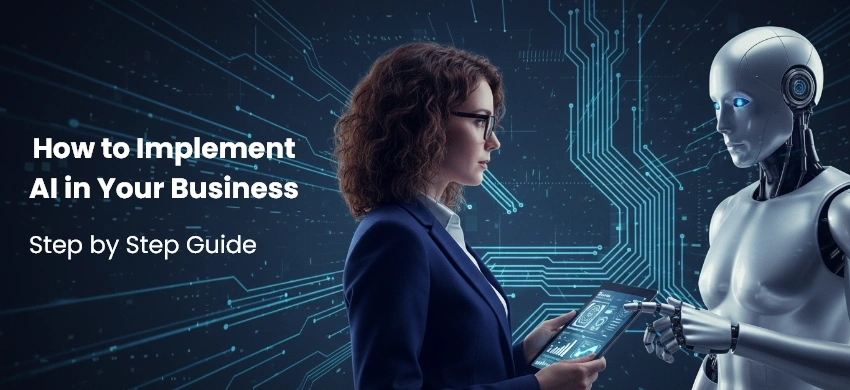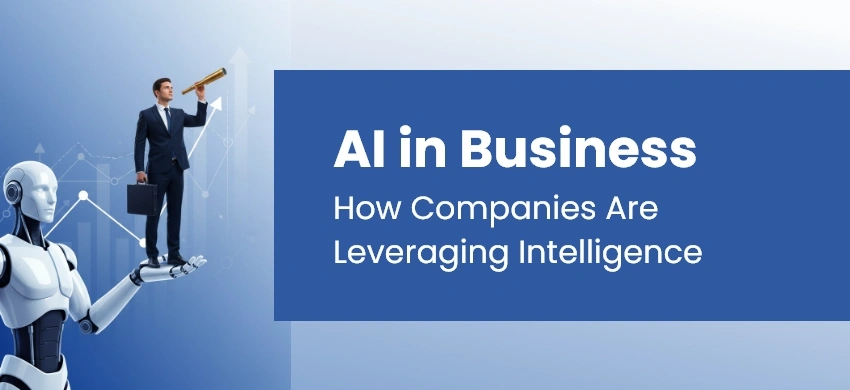
Artificial intelligence is no longer a futuristic concept. It has become a practical and powerful tool for businesses that want to operate faster, smarter and more competitively. Companies in every industry are using AI to automate tasks, improve decision making, personalize customer experiences and unlock new revenue opportunities. However, implementing AI successfully requires a structured strategy, the right data foundation and a clear roadmap.
This in depth guide explains how to implement AI in your business in a practical and strategic way. Whether you want to automate workflows, improve analytics or build intelligent digital products, this step by step process ensures your AI journey is successful and aligned with business outcomes.
Codemech Solutions offers services such as Artificial Intelligence App Development Services, AI Agent Development Services, Data Science services and AI Model Maintenance and Support Services, all of which support companies throughout their AI transformation. These service mentions are placed naturally within this guide.
Introduction to AI Implementation for Modern Businesses
AI is transforming how organizations operate. From customer support automation to supply chain optimization, companies that embrace AI early are outperforming their competitors. However, many businesses struggle because they start with technology first instead of strategy. Successful AI implementation begins with understanding your business challenges and building AI solutions that deliver measurable value.
AI is not just a tool. It is a capability that must be integrated into your existing processes, systems and culture. This guide breaks the process into clear steps that business teams and technical teams can follow together.
Step 1: Assess Your AI Readiness and Identify High Value Use Cases
Before implementing AI, your business needs a clear understanding of where AI will produce the most impact.
Analyze your current business challenges
List the problems that slow down your operations, increase cost or reduce efficiency. These could be customer service delays, repetitive manual tasks, forecast inaccuracy, complex decision processes or poor data visibility.
Evaluate your data readiness
AI depends on data quality. Check if your business has structured and unstructured data, consistent data collection methods and secure storage practices. If your data is incomplete or not centralized, consider working with Data Science services providers to set up a solid data foundation.
Identify high value use cases
Some common AI use cases include
Customer support automation with chatbots
Sales forecasting
Inventory management
Predictive maintenance
Fraud detection
Personalized customer experiences
Document processing automation
Start small with use cases that have high business value and fast return on investment.
Step 2: Define Clear AI Objectives and Success Metrics
AI implementation should support your core business goals. Define what success looks like before building any solution.
Set strategic goals
Examples include
Reducing customer service time
Lowering operational cost
Improving sales conversion
Enhancing customer experience
Automating manual workflows
Define measurable KPIs
KPIs help track whether the AI project is producing real value. Examples include
Response time improvement
Cost savings
Prediction accuracy
Customer satisfaction ratings
Automation rate
Clear objectives ensure your teams stay aligned and focused.
Step 3: Build an AI Roadmap for Your Organization
A roadmap helps your team understand what to build, how to build it and when to scale it.
Create a phased approach
Start with pilot projects Evaluate performance and refine the model Expand the solution to more departments Integrate AI into long term digital strategy
Assign ownership
Define responsibilities across engineering, data science, product and leadership teams. Decide who manages data, who builds models and who approves output validation.
Estimate resources and timeline
AI projects require data engineers, AI developers and business analysts. Using service providers like Codemech Solutions is a cost effective way to accelerate development without hiring a full in house team.
Step 4: Choose the Right AI Tools and Techniques
Your AI solution depends on your business goals and technical environment.
AI approaches you may consider
Machine learning for prediction and classification
Deep learning for complex pattern recognition
Natural language processing for text and chat interactions
Generative AI for content and automation
AI agents for workflow automation and decision support
Choose the right technology
You can use cloud based solutions, open source frameworks or custom built AI models created by an Artificial Intelligence App Development Services provider. Choose tools that integrate easily with your existing systems.
Step 5: Prepare and Organize Your Data for AI
Data is the foundation of any AI solution. Without clean data, even the most advanced algorithms will fail.
Steps to prepare your data
Collect data from all departments
Clean and remove duplicates
Standardize formats
Label training data where required
Ensure compliance with privacy and security regulations
Implementing proper data pipelines is essential. Many companies partner with data science services teams to manage data engineering and preparation.
Step 6: Build a Proof of Concept or Pilot AI Model
A pilot allows your business to test AI in a controlled environment before investing heavily.
A successful pilot includes
A clear problem statement
A minimal but functional AI model
A small but reliable dataset
Evaluation metrics
User feedback loops
The aim is to validate the idea, check feasibility and estimate long term performance.
Step 7: Train, Validate and Deploy Your AI Model
Once a pilot is successful, your AI model must be trained thoroughly and deployed into production.
Model training
Use historical and real time data
Ensure diverse data to avoid bias
Adjust parameters to improve accuracy
Model validation
Test your model with different datasets
Compare results with baseline methods
Check fairness and explainability
Deployment
Use containerization, APIs or cloud services for seamless integration Ensure monitoring dashboards are in place
Codemech Solutions offers AI Model Maintenance and Support Services to ensure your models remain accurate, updated and high performing.
Step 8: Integrate AI into Your Business Processes
AI creates value only when it is integrated into daily workflows.
Integration methods
Embed AI predictions into your CRM or ERP
Use AI chatbots inside customer service platforms
Connect AI powered analytics to dashboards
Automate workflows using AI agents
Integration may require backend upgrades, API development or UI improvements. This is where experienced AI Agent Development Services and Artificial Intelligence App Development Services become essential.
Step 9: Monitor, Maintain and Continuously Improve Your AI System
AI is not a one time project. It requires ongoing monitoring and improvement.
Monitor performance
Track accuracy, speed, cost and real world impact
Detect model drift when prediction patterns change
Regular updates
Retrain models with new data
Fix performance issues
Improve the model as your business evolves
Importance of maintenance
Without ongoing support, AI accuracy will decline. This is why many companies rely on continuous AI Model Maintenance and Support Services.
Step 10: Scale AI Across the Entire Organization
Once you have successfully deployed one or two AI solutions, you can expand AI usage across multiple departments.
Build an AI culture
Train employees to work with AI tools
Encourage innovation and experimentation
Create a small internal AI committee for governance
Examples of scaling
Using AI in finance for risk scoring
Using AI in operations for demand forecasting
Using AI in marketing for personalization
Using AI in HR for talent analytics
Scaling turns AI from a single project into a core business capability.
Common Challenges in AI Implementation and How to Overcome Them
Businesses usually face challenges such as
Poor data quality
Lack of technical skills
Unclear business objectives
Integration difficulties
Fear of operational change
These challenges can be overcome with a clear roadmap, strong leadership alignment and support from experienced AI partners like Codemech Solutions.
How to Measure AI ROI in Your Business
To prove success, track both financial and performance metrics.
Financial ROI
Cost reduction
Revenue increase
Labor savings
Operational ROI
Faster decision making
Improved accuracy
Higher customer satisfaction
Clear tracking ensures continued investment and scale.
Conclusion
Implementing AI in your business is one of the most effective ways to improve efficiency, reduce cost and drive innovation. By following a structured step by step approach, your organization can identify high value use cases, prepare its data, build reliable AI models, integrate them into workflows and scale AI across the entire company.
With the right strategy and expert support from AI solution providers like Codemech Solutions, your business can achieve long term success with artificial intelligence and stay ahead in a rapidly evolving digital world.


